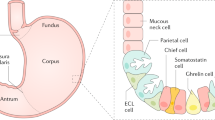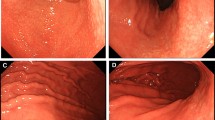Antigastric autoantibodies in Helicobacter pylori gastritis: prevalence, in-situ binding sites and clues for clinical relevance (original) (raw)
Abstract
Colonization of human gastric mucosa with Helicobacter pylori leads to chronic active gastritis and induces the occurrence of an acquired mucosa-associated lymphoid tissue (MALT) in the stomach. This remodelling of the gastric mucosa together with chronic antigen persistence may induce autoimmune reactions. The aim of this study was to investigate humoral autoimmune reactions to human gastric mucosa in H. pylori gastritis and their clinical relevance. Sera from patients with dyspeptic symptoms were tested for presence of IgG immunoglobulins against H. pylori. Gastric infection with H. pylori and alterations of gastric mucosa were demonstrated by histological examination of gastric biopsy specimens. All sera were tested for reactivity against human gastric mucosa by immunohistochemistry. Two different in-situ binding sites of antigastric autoantibodies were observed. Binding to canalicular structures within parietal cells was significantly correlated with antibodies to H. pylori, elevated basal gastrin levels and atrophy of gastric corpus glands. Our data indicate that autoimmune reactions to antigens in the human gastric mucosa occur in H. pylori gastritis and that they may play a role in the pathogenesis of the disease.
Access this article
Subscribe and save
- Get 10 units per month
- Download Article/Chapter or eBook
- 1 Unit = 1 Article or 1 Chapter
- Cancel anytime Subscribe now
Buy Now
Price excludes VAT (USA)
Tax calculation will be finalised during checkout.
Instant access to the full article PDF.
Similar content being viewed by others


Autoimmune gastritis
Article 09 July 2020

References
- Berstad K, Berstad A (1993) Helicobacter pylori infection in peptic ulcer disease. Scand J Gastroenterol 28:561–567
Google Scholar - Callaghan JM, Khan MA, Alderuccio F, VanDriel IR, Gleeson PA, Toh B-H (1993) a and b subunits of the gastric H+/K+-ATPase are concordantly targeted by parietal cell autoantibodies with autoimmune gastritis. Autoimmunity 16:289–295
Google Scholar - Dunn BE (1993) Pathogenic mechanisms of Helicobacter pylori. Gastroenterol Clin North Am 22:43–57
Google Scholar - Faller G, Vollmers HP, Weiglein I, Marx A, Zink C, Pfaff M, Müller-Hermelink HK (1990) HAB-1, a new heteromyeloma for continuous production of human monoclonal antibodies. Br J Cancer 62:595–598
Google Scholar - Graham DY, Go MF, Lew GM, Genta RM, Rehfield JF (1993) Helicobacter pylori infection and exaggerated gastrin release. Effects of inflammation and progastrin processing. Scand J Gastroenterol 28:690–694
Google Scholar - Haruma K, Kawaguchi H, Kohmoto K, Okamoto S, Yoshihara M, Sumii K, Kajiyama G (1995) Helicobacter pylori infection, serum gastrin, and gastric acid secretion in teen-age subjects with duodenal ulcer, gastritis, or normal mucosa. Scand J Gastroenterol 30:322–326
Google Scholar - Haruma K, Kawaguchi H, Yoshihara M, Okamoto S, Sumii K, Kishimoto S, Kajiyama G (1994) Relationship between Helicobacter pylori infection and gastric acid secretion in young healthy subjects. J Clin Gastroenterol 19:20–22
Google Scholar - Kirchner T, Melber A, Fischbach W, Heilmann KL, Müller-Hermelink HK (1990) Immunohistological patterns of the local immune response in Helicobacter pylori gastritis. In: Malfertheiner P, Ditschuneit H (eds) Helicobacter pylori, gastritis and peptic ulcer. Springer, Berlin Heidelberg New York, pp 213–222
Google Scholar - Kuipers EJ, UA, Pena AS, Roosendaal R, Pals G, Nelis GF, Festen HPM, Meuwissen SGM (1995) Long-term sequelae of Helicobacter pylori gastritis. Lancet 342:1525–1528
Google Scholar - Lee A (1993) _H. pylori_-initiated ulcerogenesis: look to the host. Lancet 341:280–281
Google Scholar - Marshall BJ (1994) Epidemiology of H. pylori in Western countries. In: Hunt RH, Tytgat GNJ (eds) Helicobacter pylori — basic mechanisms to clinical cure. Kluwer Academic Publishers, Dordrecht, pp 75–84
Google Scholar - Misiewicz JJ (1991) The Sydney System: a new classification of gastritis. Introduction. J Gastroenterol Hepatol 6:207–208
Google Scholar - Negrini R, Lisato L, Zanella I, Cavazzini L, Gullini S, Villanacci V, Poiesi C, Albertini A, Ghielmi S (1991) Helicobacter pylori infection induces antibodies cross-reacting with human gastric mucosa. Gastroenterology 101:437–445
Google Scholar - Parsonnet J, Friedman GD, Vandersteen DP, Chang Y, Vogelman JH, Orentreich H, Sibley R (1991) Helicobacter pylori infection and the risk of gastric carcinoma. N Engl J Med 325:1127–1131
CAS PubMed Google Scholar - Price AB (1992) The Sydney System: histological division. J Gastroenterol Hepatol 6:209–222
Google Scholar - Scheynius A, Engstrand L (1991) Gastric epithelial cells in Helicobacter pylori associated gastritis express HLA-DR but not ICAM-1. Scand J Immunol 33:237–241
Google Scholar - Uibo R, Krohn JE (1984) Demonstration of gastrin cell autoantibodies in antral gastritis with avidin-biotin complex antibody technique. Clin Exp Immunol 58:341–347
Google Scholar - Vandelli C, Botazzo GF, Doniach D, Franceschi F (1979) Autoantibodies to gastrin-producing cells in antral (type B) chronic gastritis. N Engl J Med 300:1406–1410
Google Scholar - Warren JR, Marshall BJ (1983) Unidentified curved bacilli on gastric epithelium in active chronic gastritis. Lancet 1:1273–1275
Google Scholar - Wotherspoon AC, Ortitz-Hidalgo C, Falzon MR, Isaacson PG (1991) _Helicobacter pylori_-associated gastritis and primary B-cell gastric lymphoma. Lancet 338:1175–1176
Article CAS PubMed Google Scholar
Author information
Authors and Affiliations
- Institute of Pathology, University of Erlangen-Nürnberg, Krankenhausstrasse 8-10, D-91054, Erlangen, Germany
G. Faller, H. Steininger & T. Kirchner - Institute of Pathology, University of Würzburg, Würzburg, Germany
M. Eck - Department of Internal Medicine I, University of Erlangen-Nürnberg, Erlangen, Germany
J. Hensen & E. G. Hahn
Authors
- G. Faller
You can also search for this author inPubMed Google Scholar - H. Steininger
You can also search for this author inPubMed Google Scholar - T. Kirchner
You can also search for this author inPubMed Google Scholar - M. Eck
You can also search for this author inPubMed Google Scholar - J. Hensen
You can also search for this author inPubMed Google Scholar - E. G. Hahn
You can also search for this author inPubMed Google Scholar
Rights and permissions
About this article
Cite this article
Faller, G., Steininger, H., Kirchner, T. et al. Antigastric autoantibodies in Helicobacter pylori gastritis: prevalence, in-situ binding sites and clues for clinical relevance.Vichows Archiv A Pathol Anat 427, 483–486 (1996). https://doi.org/10.1007/BF00199508
- Received: 07 August 1995
- Accepted: 21 November 1995
- Issue Date: February 1996
- DOI: https://doi.org/10.1007/BF00199508